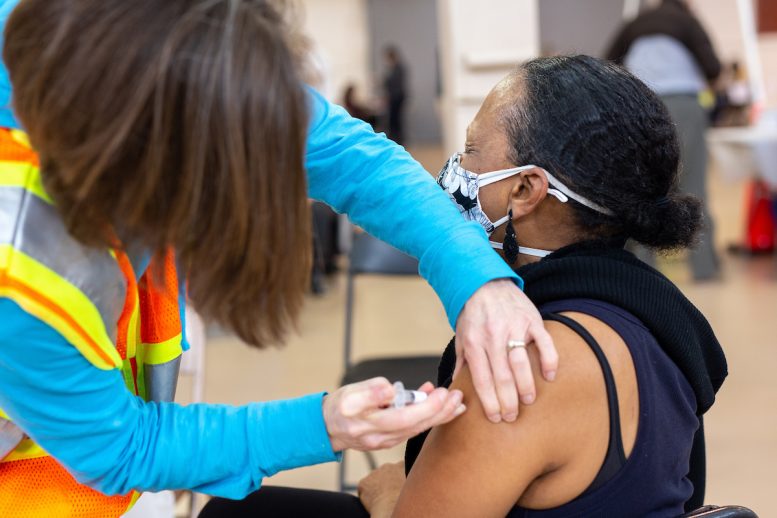About 1 in 4 unvaccinated Ohioans are hesitant to receive a COVID-19 vaccine, according to a large-scale, nationwide survey of Facebook users.
More than 26% of Ohioans surveyed Feb. 21 to Feb. 27 said they will “probably not” or “definitely not” take the vaccine, ranking Ohio the 17th most vaccine-hesitant state in the nation.
The data comes from the COVID-19 Symptom Survey from the Delphi Group, an epidemiological forecasting team at Carnegie Mellon University. The researchers gather more than 50,000 responses daily (more than 18 million since April) to gauge attitudes on different aspects of the pandemic.
“While vaccination uptake has increased, the share of unvaccinated adults who are vaccine-hesitant has remained stable at 23% … and it varies considerably by state and by race/ethnicity (20% and 29% among white and Black adults, respectively),” researchers said in a report Monday compiling findings from January and February.
The research illuminates differences of vaccine uptake along fault lines of ideology, race and age.
For instance, traditionally conservative states — Wyoming (34%), North Dakota (32%), or Alabama (32%) contain the largest vaccine-hesitant population among the unvaccinated. Progressive states like Massachusetts (12%), Vermont (14%) or Connecticut (14%) have the lowest.
Vaccine hesitancy is more prevalent among non-white groups but shrinking, the researchers found. About 20% of unvaccinated white people are vaccine hesitant, compared to 21% of Hispanic people, 8% of Asian people, and 29% of Black people.
Additionally, vaccine hesitancy is largest among unvaccinated people aged 18-24 (31%) and 25-44 (27%). Young people are less likely to face severe complications from COVID-19, and weren’t alive to experience how vaccines eradicated smallpox from the world or polio from the United States.
Of 1.9 million total respondents in the Feb. 21-27 time frame, 22.5% were found to be vaccine hesitant.
The university data squares with separate findings with a recent survey from the U.S. Census Bureau. The federal survey of Ohio households (gathered Feb. 17 through March 1) found about 23% of eligible adults would “probably not” or “definitely not” get a vaccine, compared to about 18% nationwide.
When enough people in a population are vaccinated, a “herd immunity” effect is produced in which people who are unable to take vaccines still receive some of their protective effects. Researchers estimate COVID-19’s full herd immunity threshold is somewhere between 70% and 90%, but the precise cliff is not known.
To date, a limited supply and choppy rollout have masked any underlying vaccine hesitancy problem in the U.S. However, Gov. Mike DeWine announced Tuesday, following a national trend, that all adults would be eligible for the vaccine by the end of March. This will likely bring a clearer picture of hesitancy into focus.
Vaccine hesitancy is a complex concept, likely brought on by any combination of confidence in the vaccine, complacency, ease of access, exposure to misinformation and more.
However, in what they believe to be a significant finding, the researchers found 70% of vaccine hesitant adults are concerned about a side effect. This, they said, should spark states to focus messaging around accurate information about side effects, weighing them against the context of a nasty disease and a deadly pandemic.
Side effects — including pain, redness or swilling at the injection site, or tiredness, headache, muscle pain, chills, fever or nausea — are common and may be more intense with the new vaccines.
However, available evidence shows the three vaccines authorized for use against COVID-19 are safe and effective.
The Johnson & Johnson, Moderna and Pfizer/BioNTech products each underwent large scale clinical trials, in which tens of thousands of people received either the real vaccine or a placebo. Scientists then compared health outcomes of the two groups against one another to determine the effectiveness of the vaccines, and any potential complications.
All three were extremely effective in preventing death, hospitalization or a serious infection of COVID-19. No serious, adverse side effects were connected to any of the products, which are under continuing safety review by different federal agencies. Recent analysis from the CDC of the Moderna and Pfizer vaccines (Johnson & Johnson’s was not yet authorized for use at the time) found serious side effects to be extremely rare.
More than 2.4 million Ohioans have been vaccinated against COVID-19 as of Tuesday.
***
Also from Ohio Capital Journal:
COVID deniers drop lawsuit against health department; their $130k legal fund remains
A citizen group called Ohio Stands Up dropped its lawsuit against the Ohio Department of Health after alleging the state’s orders to slow the spread of COVID-19 amounted to “absolute tyranny.”
The group of plaintiffs is comprised of eight Ohioans — including Ohio Board of Education member Kirsten Hill — who baselessly alleged that COVID-19 is no more dangerous than the flu and state government “knowingly concealed and covered up” the data that proves it. The suit is rife with conspiracy theorizing, inaccuracies and distortions surrounding COVID-19.
In its lawsuit, Ohio Stands Up asked a judge to overturn all COVID-19 health orders and award $75,000 in damages to each plaintiff.
In a filing last month, U.S. District Judge John Carr found the group failed to satisfy a legal rule requiring plaintiffs to provide a plain statement explaining their argument. He ordered them to explain themselves by March 5.
He also described the group’s filings as nearly “incomprehensible” and some of the supporting evidence of “dubious provenance and admissibility.” READ MORE
State report cards bill will be improved; testing bill passed through committee
Two bills hoping to make changes to Ohio’s education system, one immediately and one seeking long-term change, faced legislative questioning on Tuesday.
The Ohio Senate Primary and Secondary Education Committee passed a bill that to alter the state’s standardized testing plan.
Meanwhile, a bill introduced last week that would overhaul the state’s report card system was brought to the House Primary and Secondary Committee by its sponsors, with acknowledgment that the bill would be subject to change.
“We know this bill’s not perfect right, because it’s the beginning stages of a bill,” said cosponsor state Rep. Don Jones, R-Freeport. READ MORE





